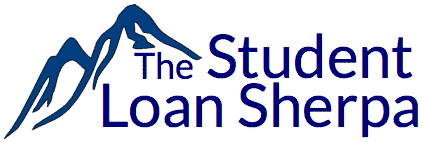Private student loans are not eligible for Public Service Student Loan Forgiveness (PSLF).
Other than a couple of rare exceptions, private loans cannot be converted into eligible federal student loans.
While it might seem that eliminating private student loans and chasing after PSLF might be entirely different goals, they are not. Borrowers dealing with private loans and considering PSLF have opportunities to achieve both goals.
Debt Elimination and PSLF Uncertainty
Many student loan borrowers face the difficult choice of chasing PSLF or opting for an aggressive repayment strategy.
The decision is much easier for borrowers with private loans. If PSLF is a possibility, but private loans are an immediate concern, borrowers can take the following steps:
- Make Progress Towards Forgiveness.
- Verify that your employer is eligible for PSLF.
- Use the Department of Education Loan Simulator to find the repayment plan with the lowest monthly payments.
- Consider enrolling in the REPAYE plan for the interest subsidy.
- Attack the Private Student Loans.
- Refinance if you can find better interest rates.
- Pay extra each month to aggressively eliminate the debt. An additional ten bucks a month can make a difference.
- Focus extra payments on the loan with the highest interest rate. Spreading out extra payments across all loans is less efficient.
This approach accomplishes a couple of important goals. First, it keeps the door open on PSLF. Second, it makes eliminating the more risky private student loans a priority.
If borrowers reach a point where PSLF is off the table, a more aggressive repayment strategy can be considered.
Private Student Loans Forgiveness or Cancellation Odds
During the 2020 election, Democratic candidates Bernie Sanders and Elizabeth Warren proposed student loan plans that included forgiving private loans.
While the Democratic party trend has been towards some form of debt elimination, cancellation of any type remains unlikely in the near future. If even some federal forgiveness is a long shot, private loan cancellation is even more unlikely.
Allowing student debt to continue to accumulate interest because of a glimmer of hope could be expensive. For most borrowers, it is a risky bet.
Balancing Other Goals with Debt Elimination
Borrowers with only federal loans can build a retirement fund and maximize forgiveness at the same time. Such a move becomes more difficult for borrowers with private loans as well.
The math gets complicated quickly, but this article provides a general guide for balancing these priorities.
Buying a house is another significant goal worth considering. Pursuing PSLF blends nicely with the strategies to qualify for a home loan, but private loans are a bit more complicated. Borrowers should pay special attention to their debt-to-income ratio when deciding which private loan to attack.
Matching the Private Loan and PSLF Timeline
Some borrowers want a target debt for debt freedom. Having a defined date may not maximize efficiency but is an excellent option if it helps borrowers stick to their goals.
PSLF provides a pretty clear ten-year timeline. As usual, things are a bit more complicated with private loans.
Borrowers can use a loan calculator to determine the exact monthly payments necessary to eliminate the loans in ten years.
Another alternative would be to refinance the private loans on a ten-year term. Interest rates on a ten-year loan are higher than the rates on a five-year loan. However, the monthly payments will be lower, and the PSLF and private student loan schedules will line up.
At present, the best 10-year fixed-rate loans are with the following lenders:
| Rank | Lender | Lowest Rate | Sherpa Review |
|---|---|---|---|
| 1 | 5.81%* | Splash Financial Review | |
| 2 | NA | SoFi Review | |
| 3 | 6.09% | ELFI Review |




